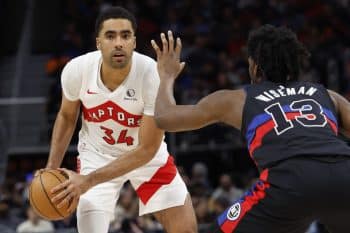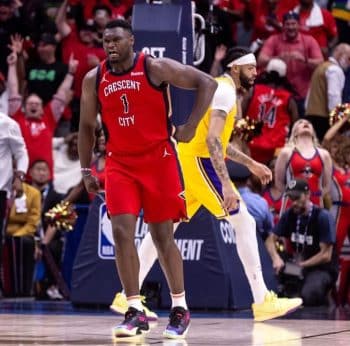NBA
NBA Sunday: The Kyle Lowry Lottery

Masai Ujiri recently inked a multiyear extension to remain the president of basketball operations. It didn’t exactly take a set of binoculars to see that one coming.
Since assuming the helm in Toronto, Ujiri has taken the franchise to one that was struggling to find itself and its identity in the wake of Jay Triano’s departure, to an ever-improving team under Dwane Casey—who seemed to be the epitome of a placeholder initially.
With DeMar DeRozan considered the franchise’s up and coming star—the one who would join Vince Carter and Chris Bosh as the torchbearers of the “We The North” movement—there were questions surrounding the long-term viability (and wisdom) of having Casey there long term.
Three straight division titles later, it’s impossible to argue with the success that the franchise has had. With DeRozan being signed to a five-year deal worth at least $139 million, you can rest assured that he will remain up north for the foreseeable future.
Is Kyle Lowry next?
* * * * * *
The relationship between Lowry, Ujiri and Casey is one that has developed magnificently over the years. It seems so long ago, but in his prior stops in the NBA—Lowry previously played for the Memphis Grizzlies and Houston Rockets—he didn’t exactly earn the reputation of a hard working, durable player. Those that knew Lowry well before Toronto would have described him as “entitled,” while others pointed to fluctuations in his weight as a symptom of simply not wanting “it” badly enough.
Now, four years after the Raptors acquired him in exchange for Gary Forbes and the 2013 first round pick that eventually became Steven Adams, Lowry joins Jermaine O’Neal as being one of the most important outliers in recent memory.
Pro basketball isn’t exactly rocket science. In general, life is cyclical. We rarely see things that we haven’t seen before and, due to the volume of players and experiences, it is advisable to rely on past experiences as indicative of future occurrences.
In other words, if a young player has All-Star potential, you will usually see it within his first three years in the league. The great Kobe Bryant didn’t become a full-time starter until his third season in the league. Neither did C.J. McCollum. But these guys are outliers.
Of the current generation of NBA superstars, young and old, it simply didn’t take all day to recognize the sunshine. LeBron James, Dwyane Wade, Carmelo Anthony, Chris Paul, Kevin Durant, Karl-Anthony Towns, Anthony Davis, Kyrie Irving, Kawhi Leonard and Russell Westbrook—how long did it take us to figure out that these guys were franchise pillars? It didn’t take long, at all.
Lowry, on the other hand, wouldn’t make his first All-Star team until his ninth season. That’s atypical.
So, along with Bryant and McCollum, Lowry joins Jermaine O’Neal as one of the most important outliers in modern history as it relates to being a late bloomer. Mainly because of their impressive depth on the interior, O’Neal sat and rotted on the bench of Mike Dunleavy’s Portland Trail Blazers for four years, averaging just 11.5 minutes per game over that duration.
Once he was moved on to the Indiana Pacers, though, O’Neal became a legitimate MVP-caliber player and was one of the most important two-way players in the entire league. He was the leader of a legitimate championship contender that was ultimately undone by a poor decision made by Ron Artest.
No, history won’t remember O’Neal as being a champion and probably won’t credit him for altering the fortunes of a franchise, but what he will do is remain the gold standard for teams that continue to believe in the potential of a young player even when he doesn’t show any immediate flashes within his first few years in the league.
Kyle Lowry now joins that conversation.
In Toronto, Lowry grew up. He developed relationships with his teammates and front office. He trusted them. He learned from them. Because of it all, he has only recently begun to fulfill the mighty potential that we all saw in him back when he was just a doughy point guard from Philadelphia.
Last week, we chronicled the Portland Trail Blazers and the decision made by that franchise to invest heavily in what was transpiring around Damian Lillard and the aforementioned McCollum. The Raptors find themselves in the same exact predicament, except youth isn’t as much on their side.
With the NBA’s salary cap expected to increase again next season, Lowry is getting ready to play the most important season of his career. Having signed a four-year contract worth $48 million in July 2014, Lowry—having retained the final year of his deal as a player’s option—will absolutely find himself as an unrestricted free agent next season.
With DeRozan earning about $27 million per season over each of the next five years, Lowry and his representatives will look at the money that was tossed around this past offseason and want their fair share. The question one should fairly ask is what that amounts to.
This past offseason, as NBA general managers were making it rain, Mike Conley got drenched. To the tune of $153 million over five years, the soon-to-be 29-year-old point guard became the unlikely recipient of the richest contract in NBA history. In all likelihood, Lowry is destined to follow in his footsteps.
With Conley, the Grizzlies were faced with a dilemma. The franchise knew that it wasn’t a championship contender with Conley, but without him they would become a laughingstock in the increasingly competitive Western Conference. In a market that saw more than half of the league’s teams with substantial cap space, plus the fact that the Grizzlies knew they were required to spend 90 percent of the salary cap, re-signing Conley for such a rich sum was easy to rationalize.
Is Lowry going to be worth a $150 million investment?
One could argue either way, but what is true for the newly re-signed Ujiri and DeRozan, is that any chance that the Raptors have to continue to moving forward begins and ends with their ability to secure Lowry for what appears to be the final multiyear contract of his career.
It is that foresight that probably helped them decide to allow Bismack Biyombo to head down to Orlando a bit easier.
Lowry is gearing up to become a recipient of one of the largest contracts in the history of the NBA. You don’t exactly need binoculars to see that, either.
And for all late bloomers, just like Jermaine O’Neal, he’s a much-needed departure from common truth. Just because it doesn’t work out on one of your first two stops in the NBA doesn’t mean it won’t work out somewhere.
As he takes up residence in Sacramento, rest assured, Ty Lawson is smiling.
* * * * * *
If the Boston Celtics and New York Knicks remain healthy and if their teams gel the way we imagine they are capable, either should have an opportunity to challenge the Raptors for their newfound supremacy atop the Atlantic Division.
On paper, the Knicks have the best point guard of the three teams, but in performance, Lowry has proven otherwise. As we approach the inevitable opt-out of the league’s current collective bargaining agreement, Lowry has emerged as a figure of interest.
Just as the Raptors have toiled and become household names, he has.
So you don’t need binoculars to see that he’s going to cash in heavily. That, you can see from a mile away.











